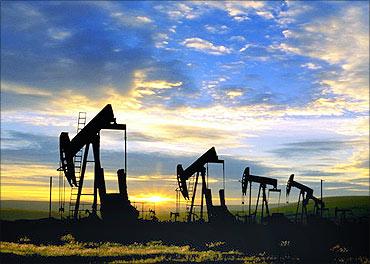One of the reasons is that the retail prices are not bench-marked to crude but their respective international benchmark prices.
 The fall in crude oil prices and fuel de-regulation have put the oil marketing companies (OMCs) — Indian Oil Corporation (IOC), Hindustan Petroleum Corporation (HPCL) and Bharat Petroleum Corporation (BPCL) — in a sweet spot.
The fall in crude oil prices and fuel de-regulation have put the oil marketing companies (OMCs) — Indian Oil Corporation (IOC), Hindustan Petroleum Corporation (HPCL) and Bharat Petroleum Corporation (BPCL) — in a sweet spot.
Although crude oil price is down 50 per cent since last year, it has not trickled down to retail prices with the price of petrol down only by 13 per cent and that of diesel by 23 per cent.
One of the reasons is that the retail prices are not bench-marked to crude but their respective international benchmark prices.
While Brent crude was at $101.9 a barrel in August 2014, it dropped to $48.6 a barrel in August this year.
According to the Petroleum Planning and Analysis Cell, the average price of the Indian crude basket was $57.7 a barrel for the first five months of 2015-16, against the average of $84.2 a barrel for 2014-15. The average price for August was lower at $48 a barrel.
The latest fuel price cut- diesel by 0.5 a litre and petrol by Rs 2 a litre was lower than anticipated, pushing up marketing margins on diesel to Rs 1.5 a litre and on petrol to Rs 3.4 a litre.
Analysts believe reforms are here to stay and are positive for the valuations of the OMCs.
“The fall in Indian retail petroleum fuel prices was lower than that in crude as the government lapped up majority of this benefit through excise duty hikes, a trend seen in other countries, too (mix of margin plus taxes),” said Harshad Borawake of Motilal Oswal in a recent report. Borawake added that the pricing freedom for the OMCs’ improved marketing earnings predictability.
The tax component on diesel rose from 18 per cent to 38 per cent; for petrol, the increase was from 30 per cent to 48 per cent.
Higher tax component in fuel price provides a cushion against the impact of sharp increase in price and ensures efficient use of forex for crude imports.
With the government providing the required subsidy on cooking gas to OMCs, it will provide these firms with a cushion against future price rise. The extra amount is being collected in a pool account.
The government has fixed its subsidy payout to OMCs for kerosene sales at Rs 12 a litre and liquid petroleum gas sales at Rs 18 a kg.
Riding on high refining margins, the first quarter of this financial year saw OMCs posting good earnings.
Higher refining margins and inventory gains helped state-run HPCL to post an 34 times increase in its net profit at Rs 1,588 crore (Rs 15.88 billion). Net profit for the corresponding quarter of last year stood at Rs 46 crore (Rs 460 million).
“The increase in profit is primarily because of higher refining margins, inventory gains and increase in refining throughput and domestic market sales,” HPCL said.
BPCL nearly doubled its net profit for the first quarter, posting a 95 per cent jump in its net profit to Rs 2,376.16 crore (Rs 23.76 billion).
IOC, the nation’s biggest oil firm, reported doubling of its June quarter net profit to Rs 6,436 crore (Rs 64.36 billion) on higher refining margin.










